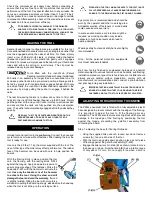
Check the compressed air supply hose before connecting to
ensure that they are free from dirt or particles that can alter the
performance of the tool. Pay special attention to any air leaks. Do
not use a compressed air pressure higher than 110 psi (7.6 bar).
Higher pressure can cause premature wear or damage to certain
components. After assembly, check all the connections to prevent
the leaks and to have maximum efficiency.
T
O PREVENT ACCIDENTAL DAMAGE TO THE FINISHED
SURFACE OF THE INSTALLED FLOOR
,
REST THE TOOL ONTO
THE SUBFLOORING WHEN CONNECTING AIR
,
LOADING TOOL
OR PERFORMING ANY MAINTENANCE TO THE TOOL
.
LOADING THE TOOL
Several feeder channel configurations are available for this tool.
Conventional feeder channels come with an integrated pusher that
must be engaged behind the nails at all time. For those, simply
insert a row of P
RIMATECH
's cleats or staples inside the feeder
channel and pull back on the plastic tab gently until it engages
behind it. To release, simply squeeze the tab with your thumb and
index and allow the spring to recoil slowly. The clip must be
released slowly to prevent damage.
Tools fitted with the
LOAD
X
TEND
(Patent
Pending) automatic feeder channel hold & feed
200 nails in an assembly no longer than a conventional one. Its
exclusive pusher locks into a pre-armed position, allowing nails to
be fed by gravity until it automatically engages behind. With only
one strip of nails, the
LOAD
X
TEND
feeder channel is operated in the
same way by simply pulling the pusher to engage it behind the
nails.
The real time-saving feature is to allow at any time to fill or add
nails into the
LOAD
X
TEND
feeder channel, up to 200 nails. Simply
pull the pusher all the way until it locks into its pre-armed position
and ensure that the nails are fully pushed into the nail ejection
area. The pusher will automatically engage behind the nails as they
pass-by.
U
SE ONLY THE TYPE OF FASTENERS IDENTIFIED ON THE
FEEDER CHANNEL
.
T
HE USE OF ANY OTHER TYPE OF
FASTENERS WILL DAMAGE THE TOOL
.
OPERATION
Unload tool and rest it onto the subflooring, Connect the hose and
cycle tool once or twice without fastener. After loading the tool, the
tool is ready for use.
Use only the 2.5 lbs (1.1 kg) hammer supplied with the tool. The
use of other type of hammers may affect performance. The rubber
face of the hammer can be used with care to help position the
boards.
With the flooring firmly in place, position the tool
onto the flooring, with the resting block P-534
against the tongue. Apply downward pressure to
ensure proper seating of the fastener. Strike the
head cap P-601 with the hammer to activate the
tool,
Use only the
RUBBER FACE
of the hammer
to activate the tool. Using the steel end will
damage the tool and void the warranty.
If wood
is slightly twisted, hitting the tool with more force
will assist in pulling the board up snugly.
NEVER
strike the head cap
when the tool is not sitting on the working surface.
O
PERATING THE TOOL WHEN THE SAFETY CONTACT IS NOT
FULLY DEPRESSED WILL CAUSE PREMATURE WEAR OR
DAMAGE TO THE DRIVING BLADE
,
PISTON AND CYLINDER
.
Eye protection is recommended and should be
worn by the operator and other in working area.
Accidental ejection of fasteners or wood debris
could cause severe eye injury.
In some environments, ear protection might be
required, as working condition may include
exposure to high noise levels which lead to
hearing damage.
Wearing safety boots and safety hat is also highly
recommended.
N
OTE
: All the personal protection equipments
must meet national standards.
Be it raw, factory finished or engineered, hardwood is a natural
material subject to various factors, such as humidity, subflooring,
installation procedure, type of tools, fasteners,
etc
. Installer should
always ensure optimal surface preparation, comply with all
manufacturer's recommendations and conduct a pre-installation
test prior beginning any installation.
B
EFORE STARTING AN INSTALLATION
,
FASTEN DOWN FEW
BOARDS TO ASCERTAIN THAT YOU ARE USING THE RIGHT
FASTENER AND THAT THE TOOL IS PROPERLY ADJUSTED
.
ADJUSTING FOR HARDWOOD THICKNESS
The P250
A
pneumatic tool is fitted with a fully adjustable plastic
base designed to prevent contact with the top edge of the flooring.
It is important to adjust the tool to fit the flooring prior any
installation. The P250
A
also features a resting block which prevent
damage to the top edge of the flooring by positioning the tool
against the tongue, preventing the gate/foot assembly from
contacting the board.
Step 1: adjusting the base for flooring thickness:
• Using the supplied Allen wrench, loosen but do not remove
screws (A); two on each side of the tool.
• With the tool in an upside down position, place a short piece
of flooring against the gate/foot assembly (P-429).
• Engage the Allen wrench in knob (B) as shown; rotate to move
the base up or down. Note that knob (B) has a rotation range
of only about 1/2 turn. Do not apply force when a limit is


























